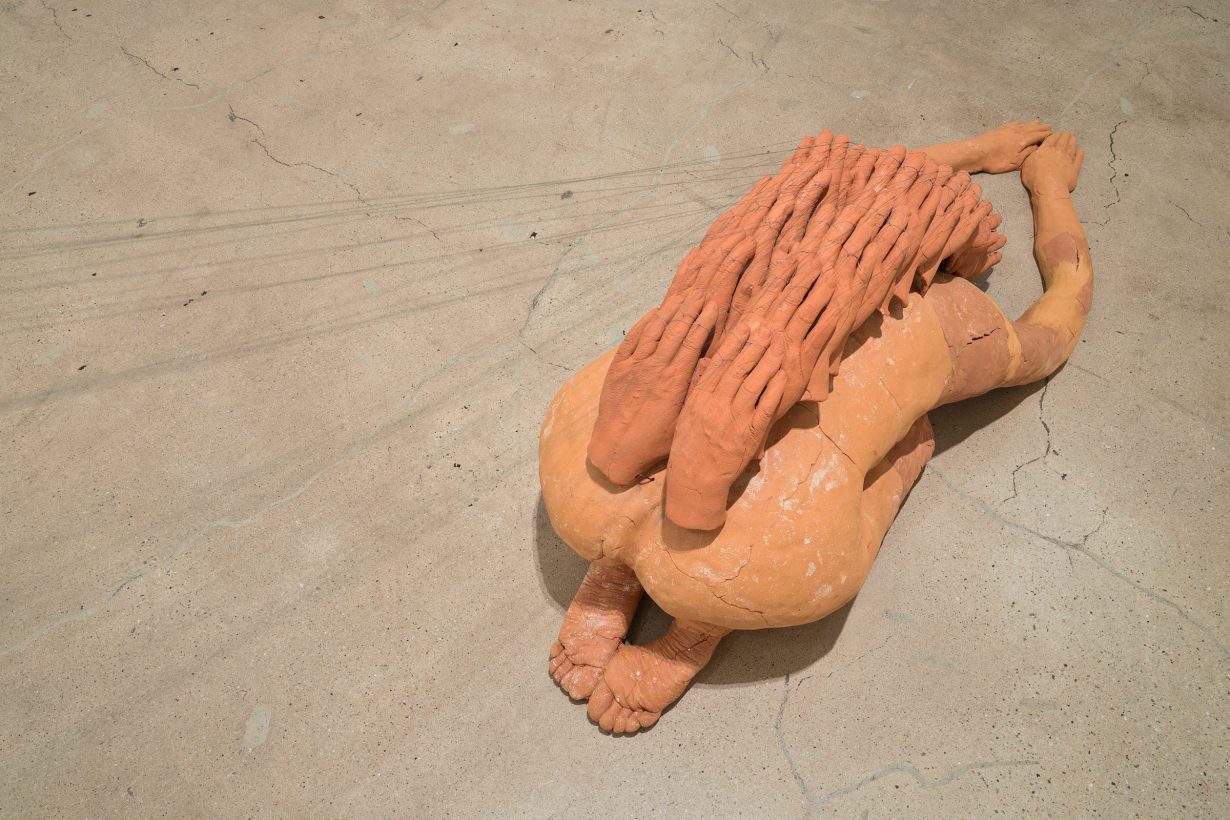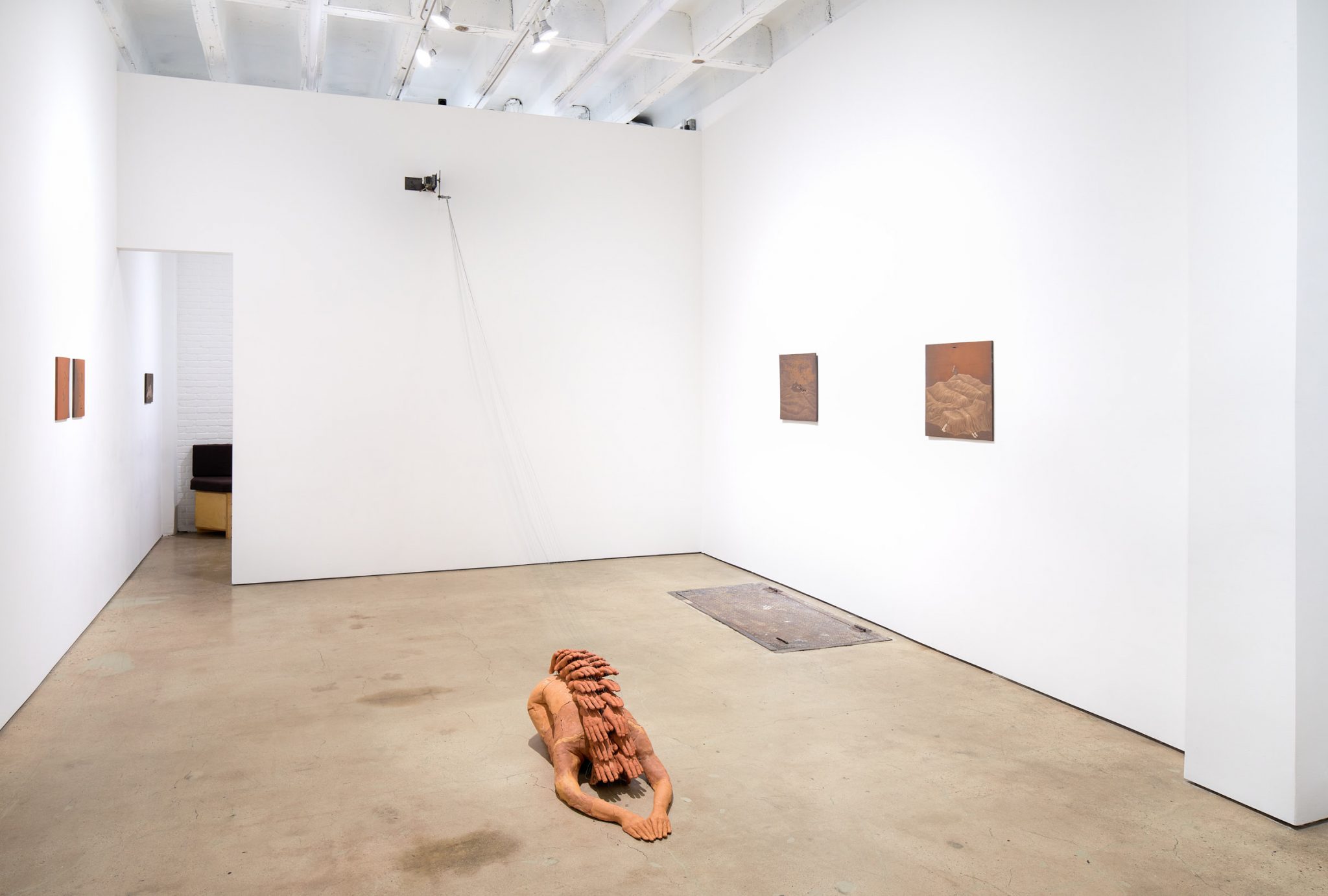The Iranian-born artist evokes self-sufficiency and introspection with faceless figures that resist the threat of collapse
Roksana Pirouzmand’s solo exhibition is a minimal affair that suffuses François Ghebaly’s one-room gallery with a sense of stoic reclusion and quietude. In the centre of the gallery is Pirouzmand’s sculpture A tap, a word (2024), a kneeling human figure rendered in terracotta. Its back is hunched like a hedgehog’s, with ten pairs of hands cascading, quill-like, down its spine. The figure’s broken head – the crown and face have been removed, leaving only ears and the suggestion of a jaw – is pressed to the floor in docility between two arms extending in full submission, while the hands on its back are strung up to a motor near the ceiling. Every five minutes, the motor starts to churn, pulling the strings from above. Amid ripples of squeaky percussion, the 20 hands rise and fall, tapping on the figure’s back, as if attempting to rouse it or give it a gentle massage. The body is a cast of the artist’s own, excluding her face, while the hands, according to the press release, are modelled after her mother’s. By reducing her mother’s touch to a set of proxy hands operated from a distance, the Iranian-born, Los Angeles-based artist gives form to feelings of absence, longing and displacement.
All work on display is made with the same four elements of earth, water, fire and air, yet Pirouzmand’s experimentation yields a fascinating breadth of material and emotional effect. In addition to the sculpture, the exhibition contains eight clay panels, placed sparsely on two white walls of the gallery, painted with different ratios of water and clay to achieve tonal variation, which results in heavily affective monochromes. The terracotta panels depict anonymous, yet seemingly related, figures engulfed in surreal landscapes. In under a sheet of mountains (2024), a figure is crushed beneath a corrugated landform; she has managed to extricate her head, arms and shoulders from the mass, but her long hair, which trails between her hands into a fold in the mountain, threatens to drag her back under the earth.

Pirouzmand punctures her tablets with entrances and exits in a consistent and almost ritualistic fashion. In the diptych counting the days until (2023), a pair of orifices are positioned symmetrically across the two panels; figures in both panels sit precariously on one another’s shoulders as their long hair is sucked into these ominous holes. The cleaved panels and yanked hair literalise the agony of severance. A series of works titled like a pebble in a riverbed (2024) are further meditations on displacement, thickened with desolation. In one, figures congregate around a dinner table, embroiled in an obscure conflict that has them curled in foetal positions and crouched in supplication, as two pairs of arms reach out from beneath the topography to pray. In another, a figure buries her face in her palms atop a mountain under an empty sun in a burnt-sienna sky with wrinkles in the colour of metallic residue.
Notably, faces are also absent in Pirouzmand’s ceramic panels, or in fact more than absent, since they’ve been physically gouged from the clay. In the orifices that remain, one sees the underlayers of the panels, confronting a physical depth that betrays the superficiality of illusionistic depiction. There is no horizon, only holes. In this way, Pirouzmand’s images effectuate a flatness reminiscent of Persian-style miniature paintings, while the hollowed faces bring to mind the legend of the Herat miniaturists in Orhan Pamuk’s My Name Is Red (1998), set in the sixteenth-century Ottoman Empire, which depicted blindness as bliss – the highest reward for a miniaturist. Pirouzmand’s figures seem unconcerned with the idea of bliss. Instead, what they seem to seek is proof of survivance and spiritual conviction within themselves.
a land to fall asleep at François Ghebaly, New York, 29 June – 3 August
